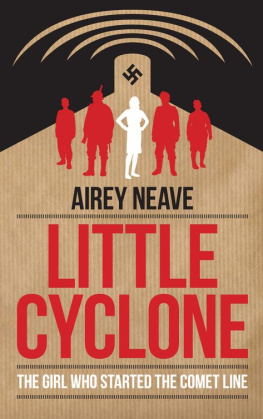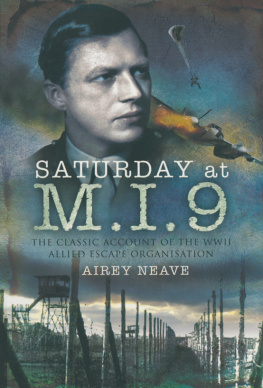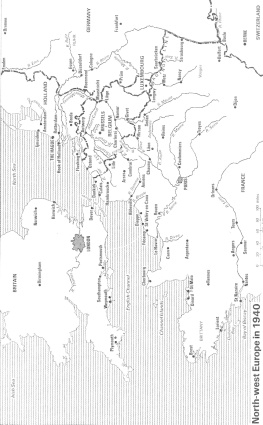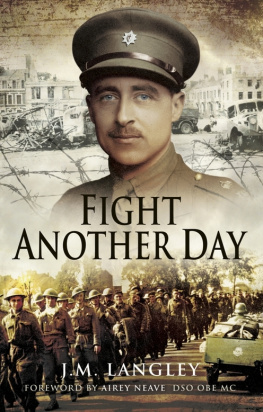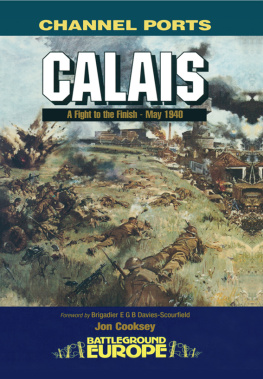ACKNOWLEDGMENTS
When Calais was captured on the afternoon of the 26th May 1940, nearly all of the garrison who were not killed or did not die of their wounds, were taken prisoner. There are therefore very few contemporary documents. Reports written in prisoner-of-war camps and official minutes and telegrams are preserved in the Public Record Office.
Brigadier Claude Nicholson died in captivity in 1943 before a report written under his direction was complete. I am grateful to his widow, the Hon. Mrs. MacDonald, and his brother, Sir Godfrey Nicholson, for personal information. Lieutenant-General Sir Euan Miller, Major A. W. Allan, Brigadier R. C. Keller, Lieutenant-Colonel R. M. Goldney and Lieutenant-Colonel John Ellison-Macartney, who held commands at Calais, read the manuscript for me and greatly added to my knowledge of the battle.
I received particular help from the Earl of Avon, Mrs. Chandos Hoskyns, Mrs. Joan St. George Saunders, Mrs. Venetia Pollock, Miss Joy Robilliard, Group Captain A. F. Anderson, Sir Everard Radcliffe, Major Quentin Carpendale, Mr. Duncan Nash and Lieutenant-Commander C. Brammall. I also wish to thank the Ministry of Defence, Lieutenant-Colonel Roger Nixon and Mr. J. M. Leslie (Regimental Headquarters Royal Green Jackets), Colonel R. H. Hordern (Royal Armoured Corps Tank Museum), The House of Commons Library and the Imperial War Museum.
The old part of Calais was totally destroyed in the war, which made research difficult. My wife did most of it, in all weathers, and my son William took the latest photographs. The Town of Calais gave every assistance through M. Saint of the Archives and M. Rrolle of the Muse, as did Mr. John Selwyn (H.M. Vice-Consul), M. S. Maupin of the Htel Meurice, Mme. Veuve, Andr Gershell, M. Georges Wiart and M. Andr Berthe.
For the German side of the story I have to thank Dr. Stahl of the Militarchiv section of the Bundesarchiv for copies of the War Diaries and other papers. These and the German photographs were obtained with the help of Major A. T. R. Shelley and Captain von Merveldt, 2nd Royal Green Jackets. The documents were translated by Mrs. Annelise Springer who also did much of the typing; so did Mrs. Patricia Saunders and Mrs. Jenny Richardson.
Most of this account of the defence of Calais is based on unpublished official and private papers but the following books and articles were of great use to me:
Eric Linklater: The Defence of Calais (H.M.S.O.)
David Divine: The Nine Days of Dunkirk (Faber & Faber)
Lord Avon: The Eden MemoirsThe Reckoning (Cassell & Co.)
Decisive Battles of World War II: The German View (Andr Deutsch)
Goutard: The Battle of France 1940 (Muller)
Maxime Weygand: Recalled to Service (Heinemann)
The Ironside Diaries (Constable)
Liddell Hart: The Other Side of the Hill (Cassell & Co.), The Tanks, Vol. II (Cassell & Co.)
Chalmers: Full CycleThe Biography of Admiral Sir Bertram Ramsay (Hodder and Stoughton)
Guy Bataille: Le Boulonnais dans la Tourmente (Pierru)
Winston Churchill: The Second World War, Vol. II (Cassell & Co.)
The Rev. Clifford Lever: On My Heart Too (Epworth Press)
Heinz Guderian: Panzer Leader (Michael Joseph)
Gordon Instone: Freedom the Spur (Burke)
Alistair Horne: To Lose a Battle (Macmillan)
Major A. W. Allan: Articles on Calais in the Rifle Brigade Chronicle 1945
J. A. Evitts: Calais 1940 Remembered (Private)
Annals of the Kings Royal Rifle Corps, Vol. VI (Brigadier G. H. Mills and Lieut.-Col. R. F. Nixon)
I am grateful to the many survivors of the battle who wrote to me. I only regret that the names of so many who deserve our gratitude are not included, but I hope that through this book their memorable resistance will no longer be forgotten.
Airey Neave
CHAPTER ONE
Was Churchill Right?
C ALAIS burned. From the Citadel to the Courgain every street was on fire. A giant, choking, cloud of smoke drifted over the harbour, so that only the spire of Notre Dame and the clock tower of the Htel de Ville could be seen from the shore.
At 3 p.m. on the 26th May 1940, Very lights were fired from the Cellulose Factory and German infantry stormed over the quays and platforms of the Gare Maritime. These were men of the 69th German Rifle Regiment of the Tenth Panzer Division. Within half an hour, they captured the Bastion de lEstran and forced the Rifle Brigade to surrender at Bastion 1. It was a savage fight with heavy loss on both sides.
At 4 p.m., the 86th Rifle Regiment had surrounded the old Citadel of Richelieu and Vauban. Led by a Feldwebel with a revolver, they crossed the courtyard and captured Brigadier Claude Nicholson, the garrison commander, who had twice refused to surrender. German tanks were in the streets of the old town or Calais-Nord firing at point-blank range. The hasty road-blocks could no longer be held. Heat, thirst and wounds ended all organised resistance. From post to post, went the last order to the 60th Rifles and those who fought with them.
Every man for himself!
It was a bitter ending for those who had fought for four days against hopeless odds. The British and French dead lay at the final barricades, on the quays and in the bastions. The wounded in the cellars cried out for water. In the tunnel under Bastion 1, a young soldier blew his brains out rather than surrender. From burning houses and trenches, came the survivors, dead-beat, but defiant. Many had bullet wounds hastily bandaged and their white unshaven faces showed the strain of tie long bombardment. When it was nearly dark, a sad but dignified column of prisoners-of-war marched off to five years of imprisonment in Nazi Germany, These were the men who had held Calais to the last hour.
Lying half-conscious on my bloodstained stretcher in the tunnel, I saw the shadow of a large figure in German uniform leaning over me. I remember now most vividly the sense of peace after the shattering roar of the battle. Until this moment the fight had raged without respite in the blazing streets.
It had been a soldiers battle. A fight to the death. In places, entire sections lay still at their posts. Why had this happened? Why were 3,000 Englishmen and 800 Frenchmen sacrificed in full view of the Kent coast, while the British Expeditionary Force was within thirty miles of them and ships of the Royal Navy stood off Calais?


